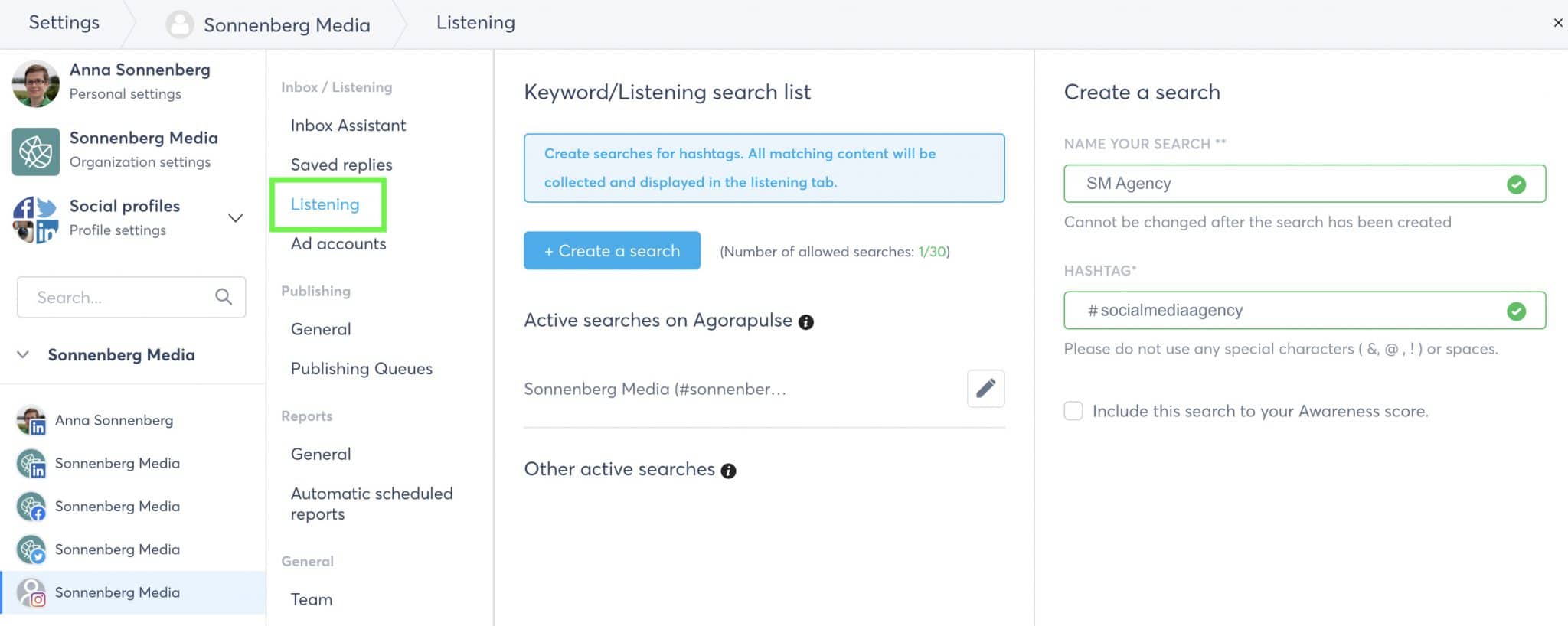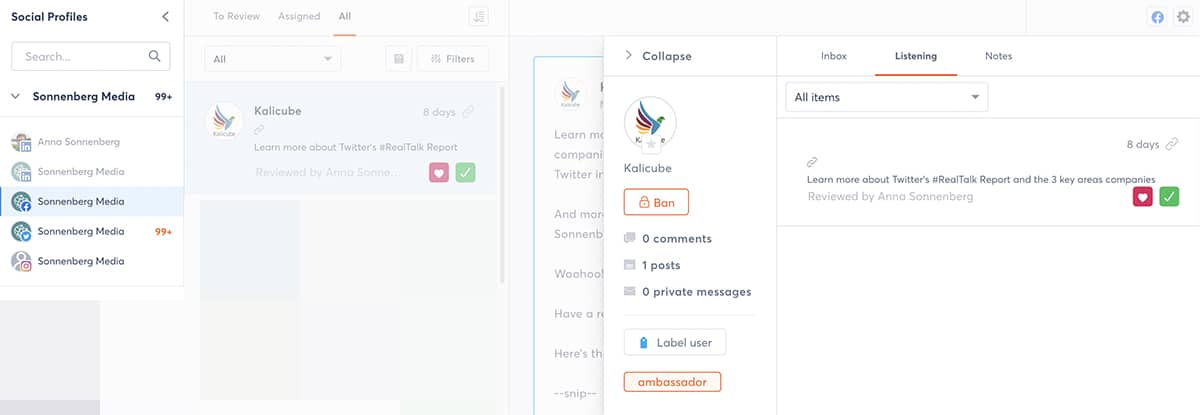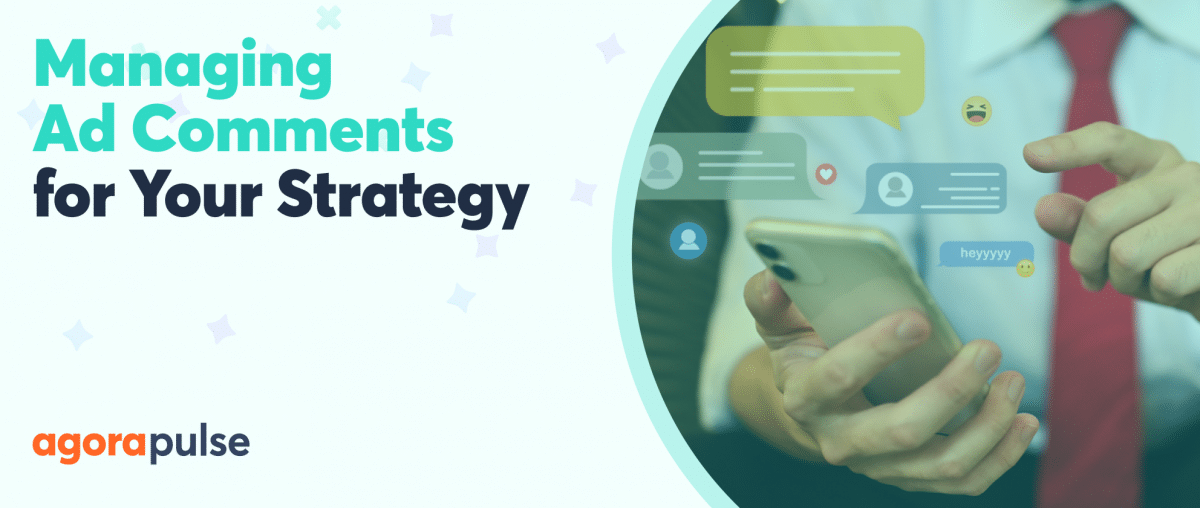For savvy marketers, social media is much more than a place for publishing posts and running ads. It’s also a channel for listening and responding to customers.
With a social media listening strategy, you can tune into what customers and prospects are saying about your brand. You also can grow your business in the process. (And try Agorapulse for free to thrive in your social media management game.)
How does social listening work? How can you include it in your team’s workflow? Let’s use these three social media listening case studies as examples.
What Is Social Listening?
Social listening is the process of finding and analyzing conversations about your brand, competitors, industry, and marketing via social media. Then you use those insights to grow your business.
On the surface, social listening is similar to social monitoring, which involves identifying and responding to relevant conversations on social media. However, social listening takes the process a step further.
With social media listening, you also gather data and draw conclusions to make smarter business decisions.
Why Is Social Media Listening Important?
By listening to conversations on social media, you can gain valuable information about your brand, your competitors, and your industry.
Here are some of the best ways to leverage social listening.
Social media listening tip: 1. Assess brand health
How are customers and prospects feeling about your brand? Are they excited about the new product line you announced? Do they think your product quality has gone downhill recently?
Social listening helps you keep an eye on the health of your brand and gives you a sense of customer sentiment. As you gather social business intelligence, you can pass it along to relevant departments. That way, they can double down on existing efforts or make improvements as necessary.
Social media listening tip: 2. Provide support
When customers want help with product and service issues, they may reach out via comments, mentions, or direct messages (DMs). But in some cases, customers may use social media to vent about your brand—without mentioning your company directly.
Social listening identifies public conversations with certain keywords, so you can easily find more under-the-radar rants. Then you can reach out with a resolution and have a chance to recover a customer.
Social media listening tip: 3. Curtail crises
If you’re lucky, problems with your products or services will affect only a handful of customers. But in some cases, a bigger issue could lead to a spike in negative sentiment or a full-blown social media crisis.
Social listening can help you identify and address problems before they generate a lasting effect. Because you can track individual conversations and monitor volume, you can respond to major issues efficiently, without compromising your brand.
Social media listening tip: 4. Monitor campaigns
Whether you’re running marketing campaigns or hosting events, you need a way to monitor what’s happening. You may also want to join the conversation, so you can capture leads and drive business.
With social listening, you can track keywords across social media channels in real time. That means you can help your initiatives succeed and maximize the value that both you and your participants extract.
Social media listening tip: 5. Identify opportunities
From paid social to search engine optimization (SEO), your organization may use a wide variety of customer acquisition techniques. In many cases, you can add social listening to the list of options.
If you add the right keywords and hashtags to your social listening routine, you can find people looking for the solutions you sell. By responding to their social media posts, you can boost brand awareness, generate leads, and even win sales.
Social media listening tip: 6. Research competitors
Social listening lets you process virtually any public social media content. That means this technique can help you discover conversations on almost any topic. That makes it ideal for competitive research, too.
When you use social listening for competitive research, you can assess customer sentiment. You can also identify common customer issues your competitors are experiencing. Then you can use your insights to inform your marketing efforts, positioning, and support.
Social media listening tip: 7. Know your industry
Social listening is also ideal for monitoring industry trends and identifying popular topics of conversation. You can use social listening tools to track industry-specific keywords, phrases, and figures so you can stay on top of what’s happening.
Then you can use what you’ve learned to create thought leadership and offer informed opinions. You can also create better content for your digital marketing.
How Do You Do Social Listening?
With the right social media monitoring tools and a simple workflow, you can master social listening. From choosing a tool to gaining insights on social data, here’s how to do social listening successfully.
1. Decide on a social listening tool
With a social listening tool, you can automate keyword and hashtag searches. Many tools also provide reporting and dashboards to help you process data efficiently.
Agorapulse
As a complete social media solution, Agorapulse has a built-in social listening tool. With this powerful tool, you can listen on Facebook, Instagram, Twitter, and YouTube—allowing you to tune in to key conversations across social media channels.
You can set up custom listening searches on Instagram, Twitter, and YouTube. Rely on Agorapulse to streamline everything from market research to competitive research.
Agorapulse automatically identifies all public brand mentions on all supported profiles. So, you can depend on Agorapulse for customer support and reputation management.
In addition, Agorapulse helps you understand how trends pan out over time. With integrated reporting tools and social media analytics, you can monitor conversation volume and assess how key topics affect your brand’s visibility.
Brandwatch
A leading consumer intelligence platform, Brandwatch specializes in social listening. This dedicated tool supports a range of social media, channels, forums, and websites, so it tracks trends and conversations across digital spaces.
Brandwatch uses artificial intelligence (AI) to analyze trends, evaluate images, and classify sentiment efficiently. That way you can get answers quickly—and you can manage your brand, avoid crises, and evaluate competitors before you’ve missed a key moment.
Talkwalker
Another top consumer intelligence platform, Talkwalker is designed to find and process the countless signals your target market sends out. With this social listening tool, you can monitor important topics on multiple channels simultaneously. That way, you can develop a more accurate understanding of your customer base—and identify shifts as they happen.
Its AI-powered technology can analyze text and images. Users can keep track of what their audience is saying and how they’re feeling at any time. You can also use this listening tool for competitive and market research. This tool can help you grow your business and stay at the top of your field—despite changes in your industry.
2. Set up searches for handles and keywords
Once you’ve chosen a tool, you can start automating social listening searches and creating dashboards. To set up a social listening search in Agorapulse, open your social profile settings, and select the profile that you want to configure.

Social listening with Agorapulse
Click to create a new search and give it a name to simplify tracking and reporting. Then enter all the keywords you want to include in the search.
Note that Agorapulse supports different search parameters for each platform. For example, Instagram allows hashtag searches, and X (Twitter) allows custom searches for handles, keywords, and phrases.

Search keywords with Agorapulse
You can also set Twitter listening searches to ignore select words, phrases, or handles. This option helps keep listening efforts on track and eliminates irrelevant content. If you need more focused results, you can always add terms to ignore later.
Agorapulse also allows you to incorporate select searches into your brand awareness score. You can also add users who appear in select searches to your Fans & Followers dashboard. That option is helpful for branded searches, as it can help you keep tabs on people who are talking about your business.
3. Respond to mentions and join conversations
Agorapulse automatically adds direct mentions to your listening tab. Once you’ve created custom social listening searches, you’ll find all the results in your inbox, separated by social profile.
To process results from one search at a time, open the Filters menu and select the search you want to view.

How to filter Social Profiles
Then click on individual items to read and join the conversation. You can reply to listening items from select channels (Twitter) directly in Agorapulse. When the API doesn’t allow for direct responses in Agorapulse, you can click to view the post on the original channel.

Your social listening inbox with Agorapulse
In some cases, it may make more sense for a team member to reply to a social listening item. You can click to assign any listening content to a team member or bookmark it for future follow-up.
You can also add custom labels to listening items so you can refer back to them later. For example, you may want to save items that appear particularly helpful for market research. You can retrieve labeled items later by using the built-in filters.

Listen in with these features
In addition to monitoring conversations, Agorapulse also lets you track relevant users when the API allows.
For example, you can monitor brand mentions and direct interactions with Facebook users from the listening tab. If a user mentions your brand regularly, you can track sentiment over time and add internal notes about your interactions.
4. Process your social listening results
To see insights from your social listening searches, go to the Reports tab and select a social profile.
Agorapulse automatically tracks the number of listening items generated each day. That way, you can identify patterns and determine whether conversations are becoming louder over time or if other circumstances are causing spikes.

Monitor spikes or drops with this listening tool
You can also see how certain hashtags and select other topics have affected your brand awareness. The dashboard automatically compares your brand awareness score to the prior period so you can see if this metric is growing steadily.

Brand awareness report score with Agorapulse
You can even use inbox labels for Agorapulse reports to track sentiment. So, you can understand if conversations are trending in a positive or negative direction. You always have the option to manually apply labels to social listening items.
To save time, you can set them to apply automatically instead.
Open the settings for the social profile in question and select Inbox Assistant. Click to create a new moderation rule and input the keywords that align with the various sentiments you want to track. For example, terms like “thank you” and “excellent” often signal a positive sentiment.

Edit rules of moderation through Agorapulse
Once you’ve set up automated rules or applied labels manually, you can track sentiment in the Label Distribution section of your report. This label report incorporates listening and inbox items to give you a complete overview of how people feel about your brand.

Label distribution with Agorapulse to see messages and tweets
Finally, work with your team to use social listening insights effectively.
For example, if you’ve found that customer sentiment has shifted in a negative direction, it may be time to identify and address the root causes. Or if you’ve found that the majority of your brand mentions relate to customer service inquiries, you may want to explore dedicated support channels.
Become a social media expert with Agorapulse for FREE today.
Three Examples of Social Media Listening Case Studies
Now that you know more about social listening’s value, check out how established brands do it.
Take a look at three social media listening case studies, and get motivated to jump right in.
Social media listening case studies: Tylenol
For decades, Tylenol products have provided people with much-needed pain relief. But over time, the types of conditions that require Tylenol have evolved.
Tylenol did social listening to learn the causes and the trends surrounding conditions that Tylenol can alleviate. Those findings help guide the company’s marketing strategy and grow the business.
While social listening, the company made an important discovery. People with hobbies requiring intense, sustained focus were increasingly reporting migraine symptoms. In many cases, knitters drove the conversation, stating that their hobby led to eye strain and migraines.
Using these insights, Tylenol adjusted its marketing and SEO strategy to incorporate this target group. The company created content designed for knitters and focus-heavy hobbies. It then reported increased website traffic.
Social media listening case studies: Fitbit
As a much newer company in the rapidly growing wearable technology space, Fitbit relies on social media for everything from customer complaints to feature requests. The company uses social listening to monitor customer sentiment and guide product development.
As the Director of Community, Allison Leahy, states, “Customer experience is really paramount to everything we do here.”
To provide customer care, Fitbit monitors social media channels closely. The company aims to respond to customer questions and complaints quickly, with the goal of creating delight and inspiring loyalty.
With a comprehensive social listening approach, the company can also identify emerging problems and gather data to improve troubleshooting. Then the organization provides insights to product teams to consider for future releases.
For example, Fitbit’s Reminders to Move feature was inspired by customer requests. At regular intervals, this feature generates a notification reminding users to be active, helping them accumulate more steps throughout the day.
Social media listening case studies: Southwest Airlines
As one of the top three busiest airlines in the United States, Southwest Airlines easily receives thousands of social media mentions on a typical day. From questions about flights and products to complaints about delays and ticketing issues, the company has to process a wide range of customer interactions.
To manage all this data, Southwest has designated a Listening Center for social listening. Here, team members monitor real-time mentions using a color-coded system differentiating positive and negative posts and tweets.
Since the social listening team is tasked with providing customer support, team members aim to address negative mentions as efficiently as possible. In fact, Southwest has set a goal to respond to any inquiry in just 15 minutes.
To build relationships with customers, Southwest relies on brand monitoring tools that track past interactions. That way, team members know right away whether social media users have engaged with the brand before. That way they can use prior context to guide future conversations.
Social Media Listening: What We Learned
Because social listening can reveal critical information about your brand, the competition, and your industry, it’s an essential process for social media marketers to master.
Those social media listening case studies demonstrate just how valuable this technique can be. May they offer inspiration for setting up a workflow that fits your team’s needs and budget.
Get started on honing your social media listening skills! Check out our free trial of Agorapulse to help you schedule, track, and measure all your social media efforts.






